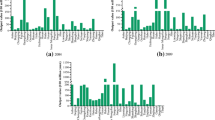Abstract
Taking the aquaculture area, the number of farming boats and that of aquaculturist as input variables, the aquaculture production as desirable output variable and polluted economic loss as undesirable output variable, this paper conducts SBM model to evaluate the aquaculture efficiency based on the data of 16 aquaculture-developed provinces in China from 2004 to 2011. The results show the efficiency in China has not changed much in recent years with the efficiency values mainly between 0.39 and 0.53, and the efficiency of marine-aquaculture-dominated provinces is generally higher than that of freshwater-aquaculture-dominated ones. To analyze the difference under the efficiency, the panel Tobit model is used with education level factor, training factor, technology extension factor, technical level factor, scale factor and species factor as the efficiency influencing factors. The results show that technology extension factor and technical level factor have significant positive influence.
Similar content being viewed by others
References
Asche, F., Roll, K. H., and Tveteras, R., 2009. Economic inefficiency and environmental impact: An application to aquaculture production. Journal of Environmental Economics and Management, 58 (1): 93–105.
Banker, R. D., Charnes, A., and Cooper, W. W., 1984. Some models for estimating technical and scale inefficiencies in data envelopment analysis. Managament Science, 30 (9): 1078–1092.
Bao, X. T., Xu, H., Zhang, J. H., and Ding, J. D., 2012. The best management practices about aquaculture of non-point source pollution control. South China Fisheries Science, 8 (3): 79–86.
Chen, Y. S., Fang, R. J., and Qiao, J., 2012. China marine aquaculture development research. Journal of Agricultural Economy, (6): 72–78.
Cinemre, H. A., Ceyhan, V., Bozoglu, M., Demiryurek, K., and Kiliç, O., 2006. The cost efficiency of trout farms in the Black Sea Region, Turkey. Aquaculture, 251 (2–4): 324–332.
Hu, H. Y., Lu, J. W., and Yang, H. S., 2003. Ecological function of macroalgae in fish culture system. Marine Sciences, 27 (2): 19–21.
Lin, D. N., Gu, X. B., and Feng, B., 2007. Technical efficiency evaluation of maoming fishery production based on DEA. Journal of Maoming College, 17 (3): 70–73.
Meng, Q. W., 2013. Research on the influence of science and technology innovation on mariculture and fine processing of aquatic products. Ocean Development and Management, (8): 94–97.
Miao, W. M., Yuan, X. H., Qian, J. R., and Su, X. Y., 2003. Research on cyprinidae fish pond farming technical efficiency. China Fishery Economy, (4): 30–5.
Muir, J., 2005. Managing to harvest perspectives on the potential of aquaculture. Philosophical Transactions of the Royal Society, (360): 191–218.
Nielsen, R., 2011. Green and technical efficient growth in Danish fresh water aquaculture. Aquaculture Economics & Management, 15 (4): 262–277.
Sun, Z. M., 2012. An empirical study on production factors’ elasticity of water aquaculture in China: Based on trans-log production function. Chinese Fisheries Economics, 30 (3): 133–139.
Tone, K., 2004. Dealing with undesirable outputs in DEA: A Slacks-Based Measure (SBM) approach. Nippon Opereshonzu, Risachi Gakkai Shunki Kenkyu Happyokai Abusutorakutoshu, 44–45.
Vassdal, T., and Holst, H. M. S., 2011. Technical progress and regress in Norwegian salmon farming: A malmquist index approach. Marine Resource Economics, (26): 329–341.
Wang, D. L., 2013. Research on China aquaculture production efficiency and its influencing factors. Ocean Development and Management, (2): 94–98.
Zhang, S. Y., Li, G., Wu, H. B., Liu, X. G., Yao, Y. H., Tao, L., and Liu, H., 2011. An integrated recirculating aquaculture system (RAS) for land-based fish farming: The effects on water quality and fish production. Aquacultural Engineering, 45 (3): 93–102.
Author information
Authors and Affiliations
Corresponding author
Rights and permissions
About this article
Cite this article
Ji, J., Wang, P. Research on China’s aquaculture efficiency evaluation and influencing factors with undesirable outputs. J. Ocean Univ. China 14, 569–574 (2015). https://doi.org/10.1007/s11802-015-2679-9
Received:
Revised:
Accepted:
Published:
Issue Date:
DOI: https://doi.org/10.1007/s11802-015-2679-9




